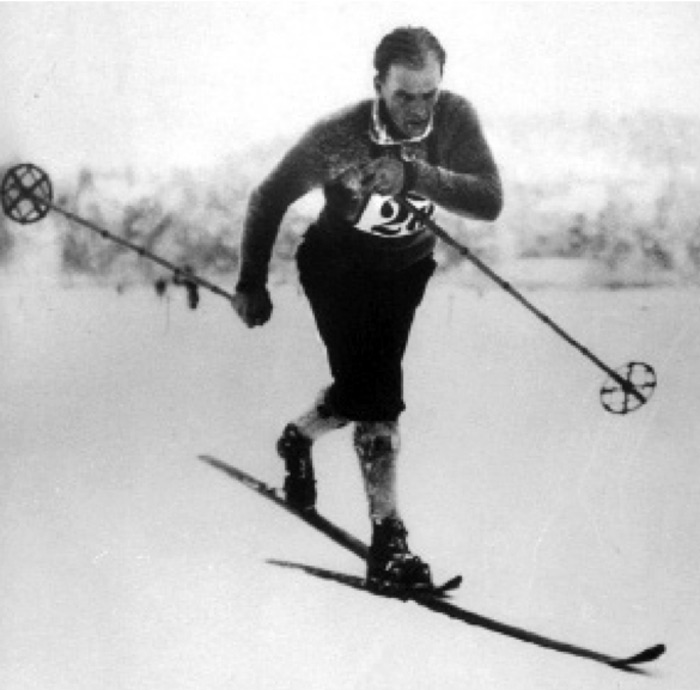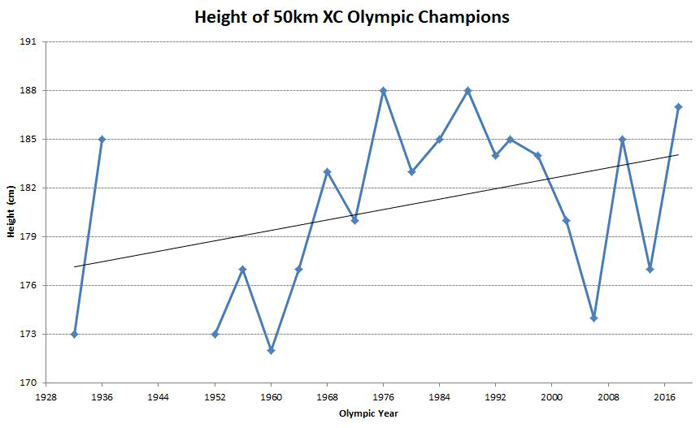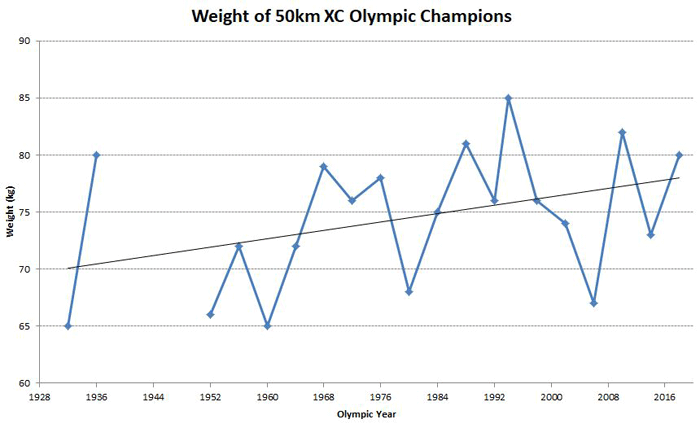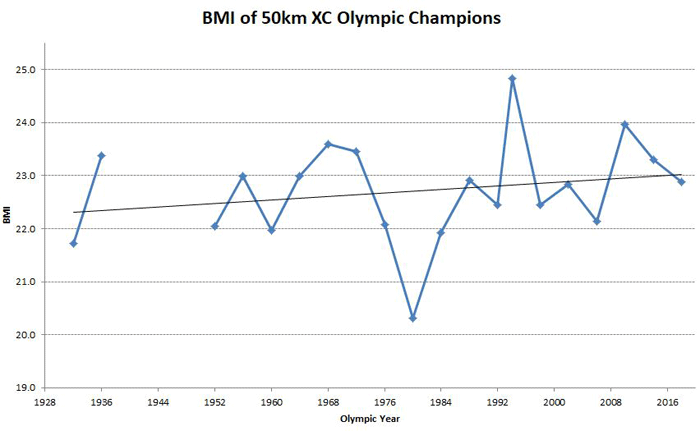The Olympic Games brings together the best athletes in the world. Studying the changes in anthropometric measurements of Olympic champions can demonstrate how athletes in general have changed over 100 years of sport.
 Thorleif Haug (Norway) won three gold medals
Thorleif Haug (Norway) won three gold medals at the inaugural 1924 Winter Olympics
at Chamonix, France
Anthropometric Measures of Olympic Cross-Country Skiers
Here is a table of the age, height, weight and body mass index (BMI) of the male Olympic champion 50km Cross-Country Skiers for most Winter Olympics (details from a few of the early Olympics are unavailable).
The graphs presented below show how these measures have changed over time. Generally, there is a trend for increasing height and weight over time, and BMI was fairly consistently between 22 and 24. The age of the Olympic champion ranged from 24 to 35 years (average 27.7 years).
The average of all Sochi 2014 Olympic cross-country participants (which includes athletes from all events) was height 1.80m, weight 74.7kg and BMI 22.9.
| Year | Winner | Age | Height | Weight | BMI |
|---|---|---|---|---|---|
| 1924 | Thorleif Haug | 29 | - | - | - |
| 1928 | Per-Erik Hedlund | 30 | - | - | - |
| 1932 | Veli Saarinen | 29 | 173 cm (5 ft 8 in) | 65 kg (143 lb) | 21.7 |
| 1936 | Elis Wiklund | 26 | 185 cm (6 ft 1 in) | 80 kg (176 lb) | 23.4 |
| 1948 | Nils Karlsson | 30 | - | - | |
| 1952 | Veikko Hakulinen | 27 | 173 cm (5 ft 8 in) | 66 kg (146 lb) | 22.1 |
| 1956 | Sixten Jernberg | 26 | 177 cm (5 ft 9.5 in) | 72 kg ( 159 lb) | 23.0 |
| 1960 | Kalevi Hämäläinen | 27 | 172 cm (5 ft 7.5 in) | 65 kg (143 lb) | 22.0 |
| 1964 | Sixten Jernberg | 35 | 177 cm (5 ft 9.5in) | 72 kg (159 lb) | 23.0 |
| 1968 | Ole Ellefsæter | 29 | 183 cm (6 ft 0 in) | 79 kg (174 lb) | 23.6 |
| 1972 | Pål Tyldum | 29 | 180 cm (5 ft 11 in) | 76 kg (168 lb) | 23.5 |
| 1976 | Ivar Formo | 24 | 188 cm (6 ft 2 in) | 78 kg (172 lb) | 22.1 |
| 1980 | Nikolay Zimyatov | 24 | 183 cm (6 ft 0 in) | 68 kg (150 lb) | 20.3 |
| 1984 | Thomas Wassberg | 27 | 185 cm (6 ft 1 in) | 75 kg (165 lb) | 21.9 |
| 1988 | Gunde Svan | 26 | 188 cm (6 ft 2 in) | 81 kg (179 lb) | 22.9 |
| 1992 | Bjørn Dæhlie | 24 | 184 cm (6 ft 0.5 in) | 76 kg (168 lb) | 22.4 |
| 1994 | Vladimir Smirnov | 29 | 185 cm (6 ft 1 in) * | 85 kg (187 lb) | 24.8 |
| 1998 | Bjørn Dæhlie | 30 | 184 cm (6 ft 0.5 in) | 76 kg (168 lb) | 22.4 |
| 2002 | Mikhail Ivanov | 24 | 180 cm (5 ft 11) | 74 kg (163 lb) | 22.8 |
| 2006 | Giorgio Di Centa | 33 | 174 cm (5 ft 8.5 in) | 67 kg (148 lb) | 22.1 |
| 2010 | Petter Northug | 24 | 185 cm (6 ft 1 in) | 82 kg (181 lb) | 24.0 |
| 2014 | Aleksandr Legkov | 30 | 178 cm (5 ft 10 in) | 73 kg (161 lb) | 23.3 |
| 2018 | Iivo Niskanen | 26 | 187 cm (6 ft 1.5 in) | 80 kg (176 lbs) | 22.9 |
| 2022 | Alexander Bolshunov | 25 | 185 cm (6 ft 1 in) | 83 kg (183 lb) | 24.3 |
source: height and weight data was mostly collected from the Wikipedia profiles of each athlete, and when none was available, from the sports-reference.com website. For the 2014 Games, the data was from the Sochi athlete database.
Height changes over time
The height of the Olympic Cross-Country 50km champion has varied greatly over time, with a general trend of increasing height over time. The height of the Olympic champion has ranged from 172 to 188cm (5 ft 7.5 inches to 6 ft 2 inches). The average height of the Olympic champion was 181cm (5 ft 11 in).

Weight changes over time
The weight of the Olympic Cross-Country 50km champion has also shown a trend of increasing over time. The weight of the Olympic champion has ranged from 65 to 85 kg (143 to 187 lbs). The average weight of the Olympic champion was 74.5 kg (164 lbs).

BMI changes over time
The BMI of the Olympic 50km Cross-Country champion has been generally between 22 and 24, and there has been a small trend of increasing BMI over time. The average BMI of the Olympic champion was 22.7.

Note: This analysis is for illustrative purposes only. The data was from different sources, and may also not accurately represent their measurements at the time of their race.
Related Pages
- Science and the Winter Olympic Games
- Science and the Summer Olympic Games
- Cross-Country Skiing at the Winter Olympics
- Athlete Body Size Changes Over Time
- About Cross-Country Skiing


 Current Events
Current Events